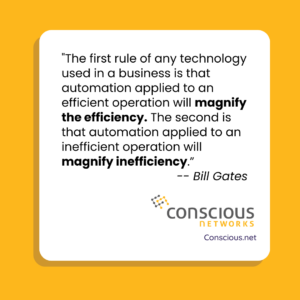Maximize Efficiency with Better Information Technology
In 1999, Bill Gates famously said, “Information technology and business are becoming inextricably interwoven.” Over 20 years later, this is not only true, but arguably understated. Today’s business leaders must align their technology with efficiencies, growth and revenue goals, while staying ahead of their competitors. In this article, we’ll explore how to maximize business efficiency with information technology.
The Impact of Technology on Business Efficiency
Many think that technology always improves the efficiency of a business. However, this is a misnomer that must be addressed head on. Going back to Bill Gates, “The first rule of any technology used in a business is that automation applied to an efficient operation will magnify the efficiency. The second is that automation applied to an inefficient operation will magnify inefficiency.”
This is an important concept to understand because the way in which a business acquires, implements, and integrates technology has a real financial impact and efficiency of a business, or lack thereof. Here is an example of how this can manifest itself in a real-world environment.
ABC company has been dealing with an outdated system for the sales team for quite some time and have budgeted for a significant upgrade to their technology platform. They have received input from sales leadership. The IT team has researched options and has a few suggestions of technology that will solve their needs. The summary and recommendations are sent to the leadership team for approval. The product is purchased, user licenses are acquired, and the implementation process begins.
As the roll-out occurs, things are going well. Training has occurred, the sales team is excited, and the implementation is going well. However, shortly after implementation, the sales team notices there a few key elements of the technology that are missing and not ideal for their everyday use. In addition, they realize that it will take additional time for the sales team to manually lookup information that should have been migrated from the old platform. In addition, the operations team notices that the data that is coming from the new sales system needs to be manipulated in order to be integrated with Accounting and Inventory systems.
This is a common scenario where a business implements technology to solve one problem within their organization while negatively impacting other departments. This can also have an impact on user adoption, processes, and operations. It illustrates why it is so critical to implement technology with a holistic approach for it’s integration or impact on the entire organization’s technology.
Interweaving Business & Technology
The takeaway here is that business efficiency may not always be maximized with new technology. In many cases, it is important to look holistically at technology and the entire organizational workflow and processes to determine what technology provides the most benefit, has a lower total cost, and will best integrate with other existing technologies. That is a puzzle that is not always quick and easy to solve. In addition, carefully evaluating the impact of technology, options for implementation, and smooth integration creates the best solutions.
Technology has become so intricate and specialized that it is rare for any medium to large sized business to make all their own decisions autonomously. Most organizations rely on strategic partners to help them understand the technology and the way it will impact their business units. However, if a business relies solely on the vendor selling a product to provide unbiased guidance, this can be a risky proposition. This is where a strategic technology partner can be invaluable.
Strategic Technology Advisor
Since it is true that information technology and business are interwoven more than ever, many businesses rely on a trusted strategic partner, or a technology advisor, to help them with major technology decisions. A technology advisor can support your internal team with more resources to sort through the sales propaganda, evaluate the integration issues in-depth, and create a seamless implementation process. This approach allows your team to focus on core competencies while potentially tapping into a much deeper and wider resource for major technology decisions.
Conscious Networks is a technology advisor that can assist with these types of important business decisions to help you maximize business efficiency with information technology. Schedule a consultation today!



